The hosting provider for the blog moved the blog to a new server infrastructure earlier last week. Apart from problems getting e-mail working again, everything seems to be working, however this will be the first post to be sent out via the e-mail subscription service, so I hope it is received. As well as the blog being moved, the weather last Wednesday was wonderful, so I did what seemed a good choice on a day of sunny weather, I headed to the Isle of Dogs and the Greenwich Foot Tunnel.
The Greenwich Foot Tunnel is at the southern tip of the Isle of Dogs, to the western side of Island Gardens, one of the best places to stop and take in the view across the river to Greenwich:

Island Gardens are relatively small, but a very welcome area of green, open space facing onto the river. View through the trees of the four chimneys of the old Greenwich power station across the Thames:
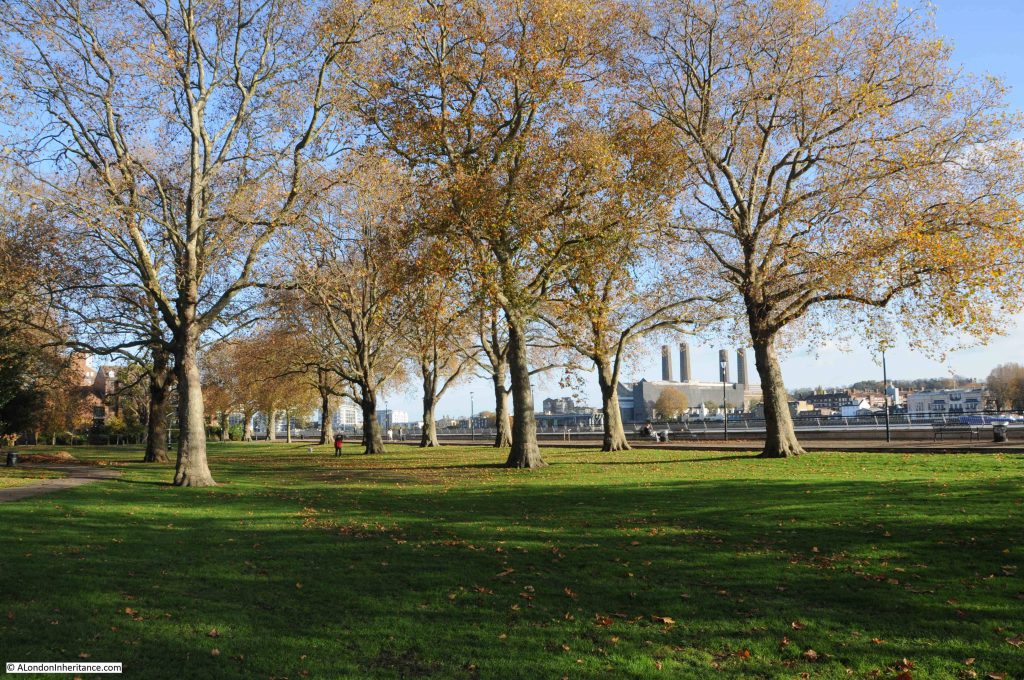
It would have been easy to stop and watch the river for some time, however after a walk from Poplar Station on the DLR, I wanted to cross to the other side of the river before the sun set too low on a late autumn day.
There are almost identical entrances to the Greenwich foot tunnel on both sides of the river. This is the entrance in Island Gardens, with a low sun directly behind the entrance:

On the opposite side of the river, the translucent glass roof of the Greenwich entrance can be seen alongside the Cutty Sark:
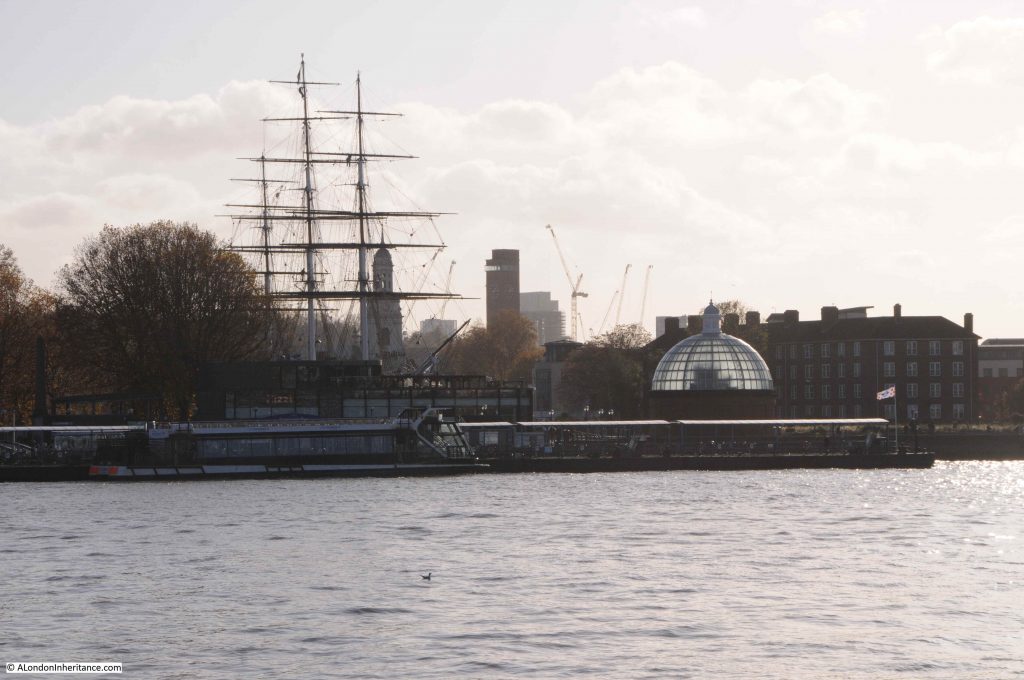
The Greenwich Foot Tunnel was one of a number of tunnels constructed under the River Thames in the late 19th and early 20th centuries. Those wanting to travel between the north and south sides of the river had long been restricted to a ferry, or long journey to the nearest bridge in central London.
A single tunnel Blackwall Tunnel had opened in 1897, the Greenwich Foot Tunnel in 1902, the Rotherhithe Tunnel in 1908 and the Woolwich Foot Tunnel in 1912.
A period of fifteen years that had opened up a range of new routes to travel between opposite sides of the River Thames, no doubt one of the benefits of having the London County Council responsible for major works across the city.
A foot tunnel for those who lived and worked on different sides of the river, or who had business that needed a crossing, had been identified as an urgent need for a number of decades in the second half of the 19th century, however it was not until the final five years of the century that the scheme would get underway.
On the 12th May 1896, newspapers were reporting that a Bill for the tunnel was to be put before Parliament:
“PROPOSED NEW THAMES TUNNEL. A LONDON COUNTY COUNCIL SCHEME – The Bridges Committee of the London County Council have prepared a report, to come before the Council today, recommending that application should be made to Parliament for power to construct a foot passenger tunnel to connect Greenwich and Millwall, at an estimated cost of £75,000, and that the Parliamentary Committee of the Council be instructed to prepare the necessary Bill, to be introduced in the Session of 1897.
The report states that, in addition to the above amount, which is the estimated cost of land and works for the proposed tunnel, a sum of not less than £25,000 as the law at present demands, would have to be paid as compensation to persons interested in a ferry which exists at the spot in question; but it is hoped that the Council will succeed in obtaining a clause by which ‘improvement of interest will be considered, thereby reducing this amount very considerably.’
The plan is to have a tunnel with a footway of eight feet, and a headway of rather more than nine feet in the centre, reduced to a minimum of seven feet and a half at the outsides. Electricity is to be used for lighting the tunnel, as also for working the ventilating and pumping machinery. The time required for the execution of the works is expected to be about twelve months, Calculations are given to show that the proposed tunnel would be a more economical provision than establishing a free ferry.”
The London County Council estimated a cost of £75,000 for the construction of the tunnel, and this was the value put forward in the Bill to Parliament, however as with almost every major civil engineering project since, the cost would turn out to be much higher.
The council invited tenders for the construction of the tunnel, and the winning tender was from Messrs. J. Cochrane with a price more than one third above the estimated cost. The Bridges Committee recommended that the council accept the bid, however the council were not happy and wanted the additional third of the estimated cost to come from “local or other sources”, however when put to the vote, the recommendation of the Bridges Committee was accepted and the work would soon commence.
The new tunnel was opened on the 4th of August 1902.
The route down to the tunnel is via several flights of stairs from the entrance in Island Gardens. The lifts are currently out of use.
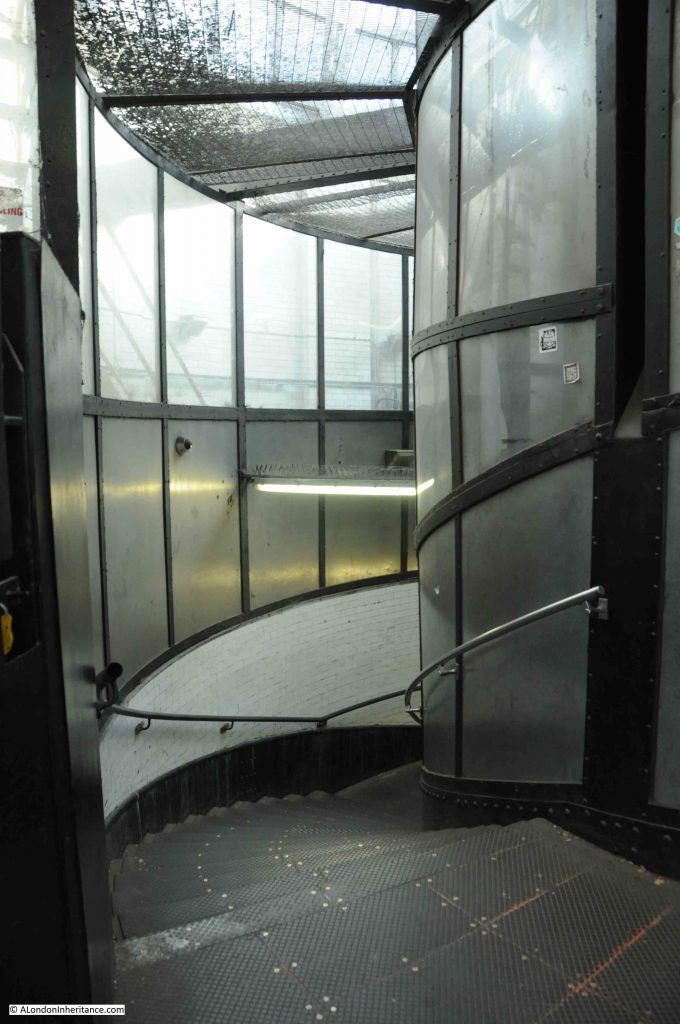
Spiral stairs line the inner wall of the shaft, with the central space being used for the lift:

From the bottom of the Island Gardens shaft, the view along the tunnel towards Greenwich:
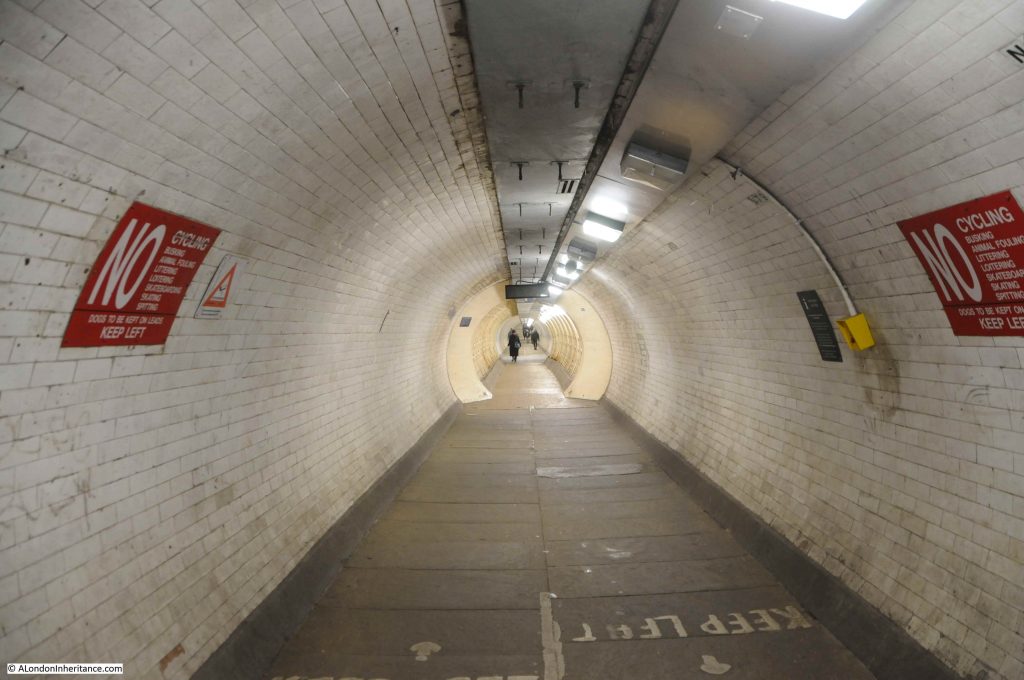
In the above photo, a cream coloured section can be seen a short distance along the tunnel.
The section is the temporary war time repairs following damage caused to the tunnel by the nearby explosion of a high explosive bomb. A closer view is seen in the photo below, and there is an information panel on the left:
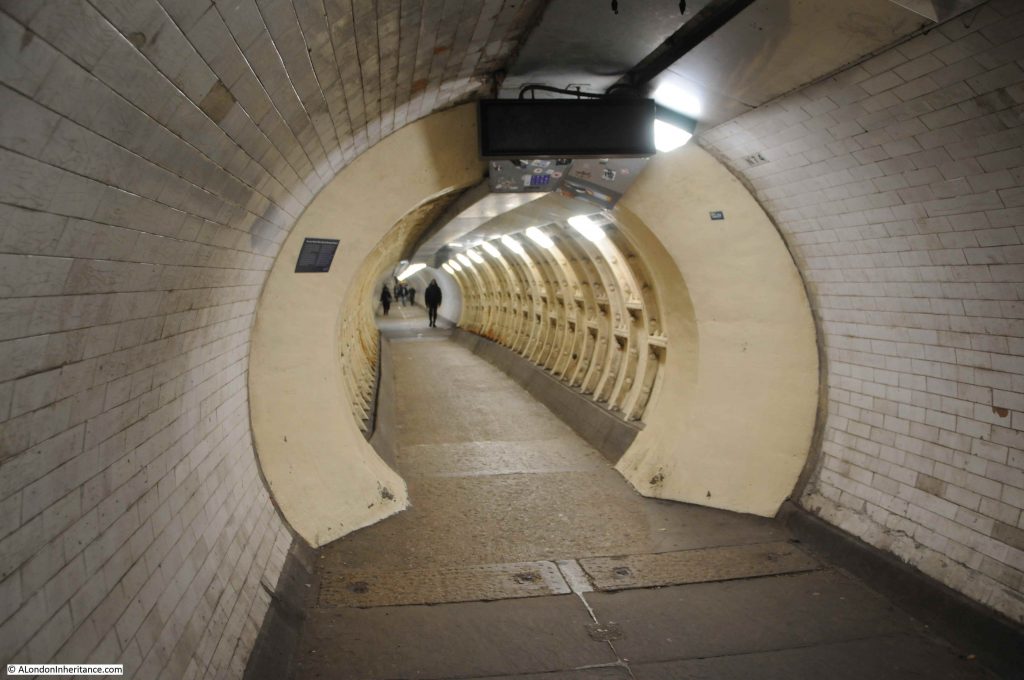
The damage to the tunnel happened on the evening of the 7th September 1940, when a bomb exploded on the foreshore, over the route of the tunnel.
Within the tunnel, the blast caused the outer tiles and inner concrete lining of the tunnel to collapse over the length of the tunnel now covered by the temporary repairs. The outer iron lining appears to have held, however this was now leaking and water was entering the tunnel to such an extent that a week after the bombing, the tunnel was full of water.
The tunnel was such a key part of the local infrastructure, providing workers living on the south of the river with easy access to the docks, ship yards and factories in the Isle of Dogs and east London, that a repair of the tunnel was essential.
It took around ten days to pump out the majority of the water, enough that work could start on repairs.
Being wartime, a temporary repair was put in place, consisting of a length of iron collars bolted together to line the damaged area, and effectively form a smaller tunnel within the larger tunnel. At the time, these repairs were considered sufficient to last the war, following which, more permanent repairs could be put in place, and the tunnel restored to its original size.
As well as infrastructure projects always running well over their initial budget estimates, temporary repairs also often become permanent, and so it is with the repairs in the Greenwich Foot Tunnel, and the cream coloured iron rings, reducing the diameter of the tunnel, are still the result of the original 1940 repair work.
Walking through the temporary repairs and at the end we can see the tunnel continuing on down to the lowest point roughly under the center of the Thames.
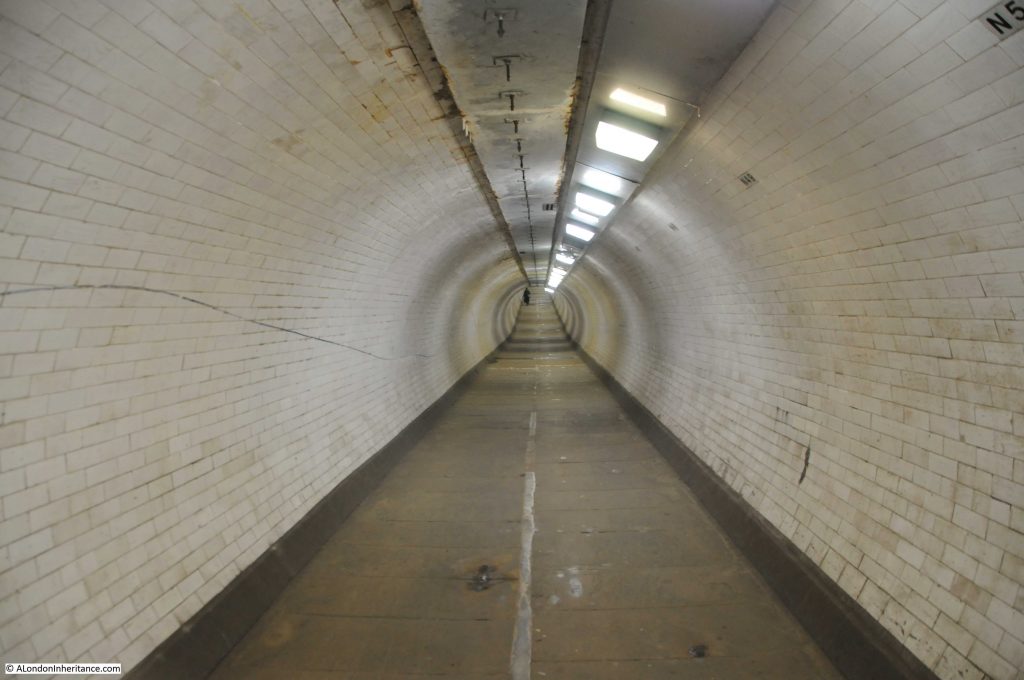
Now we are roughly in the center of the tunnel, it is a good place to stop and consider the original construction.
I have a fascinating little booklet called “The Greenwich Footway Tunnel by William Giles Copperthwaite and Subaqueous Tunneling Through The Thames Gravel: Baker Street and Waterloo Railway by Arthur Harry Haigh”.
The booklet is an extract of the proceedings of the Institution of Civil Engineers, and was published in 1902, the year the Greenwich foot tunnel opened. It is a wonderful little booklet with details of tunneling below London and the impact of the geology through which the tunnels are constructed.
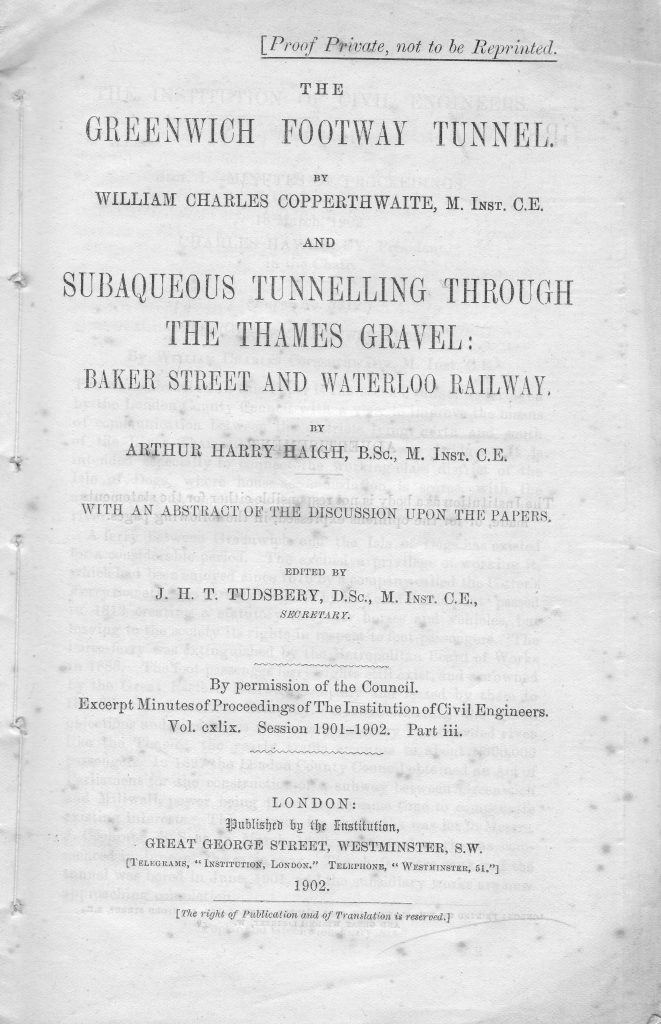
The first part of work to build the tunnel was the sinking of the shafts down to the point where the tunnel could start to be bored under the Thames.
The shafts were formed by sinking a caisson around the edge of the shaft, as the shaft was gradually excavated. A caisson is basically a hollow ring of iron or steel that forms a tube from top to bottom of the shaft and provides the strength to stop the sides of the shaft collapsing inwards, or the walls deforming.
The shafts, as with the whole of the tunnel, were constructed in an environment of compressed air. This method was used to control the ingress of ground water and to provide some support to the ground through which the tunnel is being bored. The use of compressed air did require some additional support for the workers, and faclities such as air locks to provide access to the work face.
The following diagram shows the method of sinking the caissons. The shaft was sunk through the water level which was found at a depth of 35 feet, from which point, construction continued using compressed air.
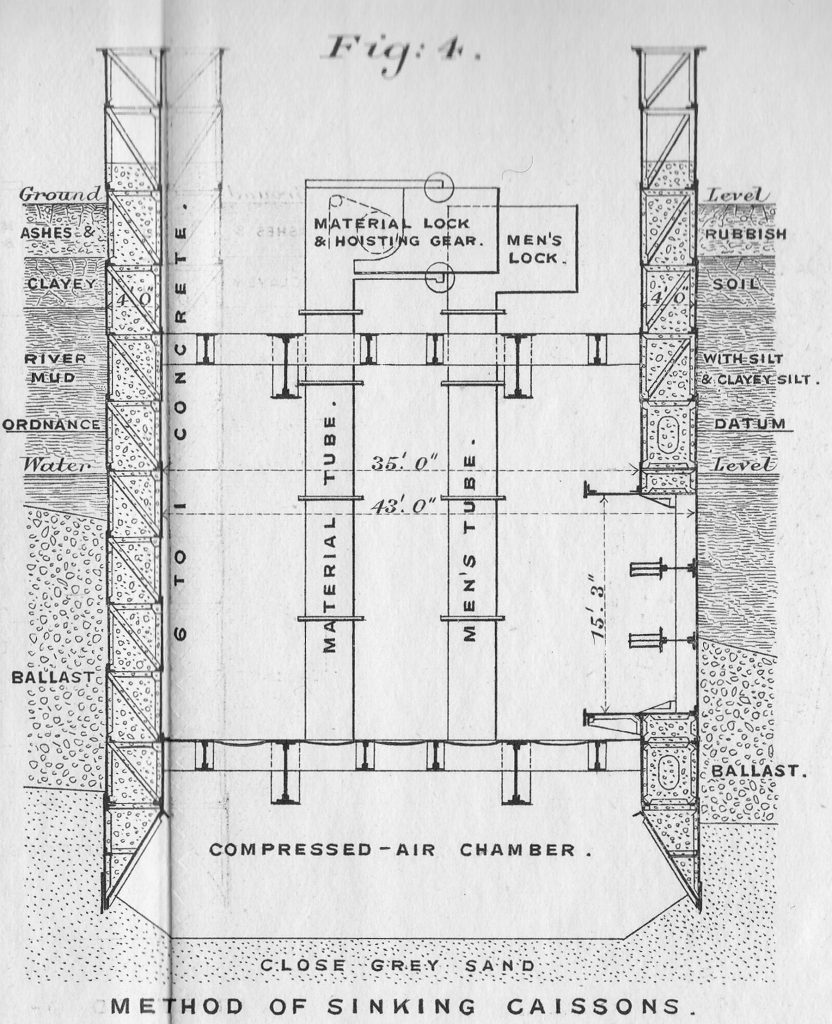
The caissons, today the walls of the shaft, are made up of two steel rings. The outer diameter of the shaft is 43 feet, and the inner diameter is 35 feet. Allowing for the width of the two steel rings (one outer, one inner), there was a four foot gap between the two rings of the shaft. This was filled with a mix of 6 to 1 Portland cement concrete. The use of concrete as a filling between the two rings meant that accurate construction and fitting of the rings was essential as once the concrete was poured, there was no way to make any further adjustments.
This method of construction created a pair of incredibly strong shafts on either side of the river, and the weight of the caisson forming the wall of the Poplar shaft was a remarkable 2,560 tons.
Compressed air was put in place from the 2nd of May, and the following table records the depth below the surface achieved each day until completion of the Poplar shaft on the 31st May, 1900.
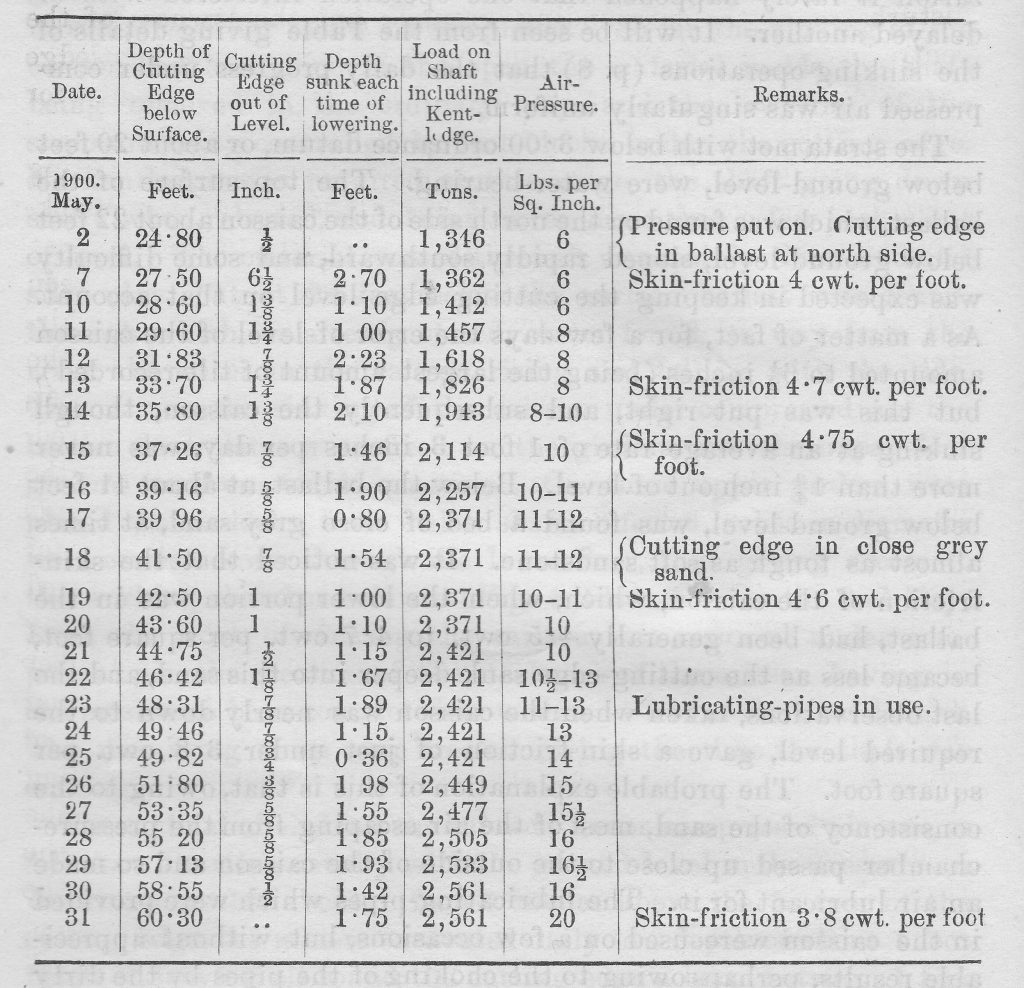
The table also shows the accuracy of the excavation by the very small amounts that the cutting edge was out of level. The increasing weight of the caisson can be seen by the load on the shaft.
The following drawing shows the route of the tunnel between the Poplar and Greenwich shafts. Note that just above the Greenwich shaft is the Ship Tavern. This pub was badly damaged during the war, demolished, and the Cutty Sark is now on the site of the pub.
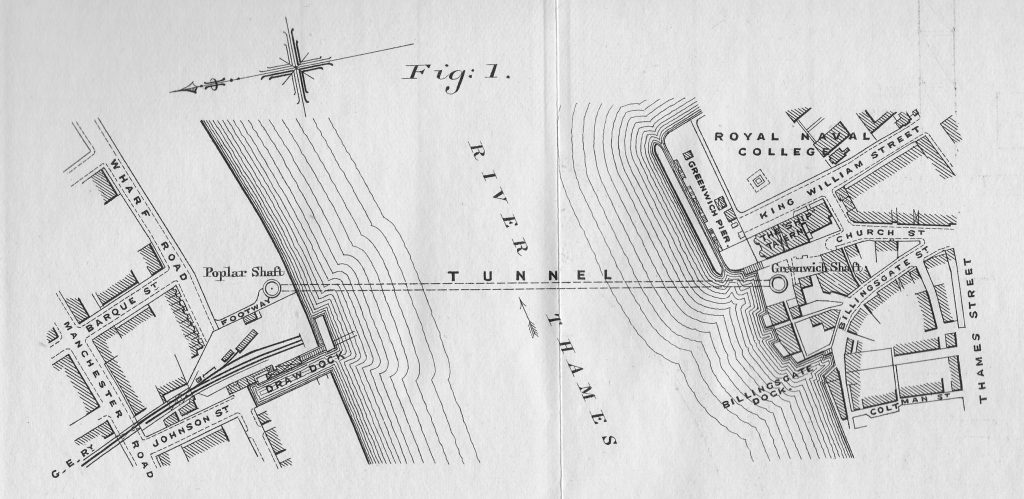
The following drawing shows a cross section of the tunnel. As will be seen in my photos of the tunnel today, the tunnel descends from both shafts with a gradient of 1 in 15 feet, down to the central part of the tunnel where it passes under the deepest part of the Thames.
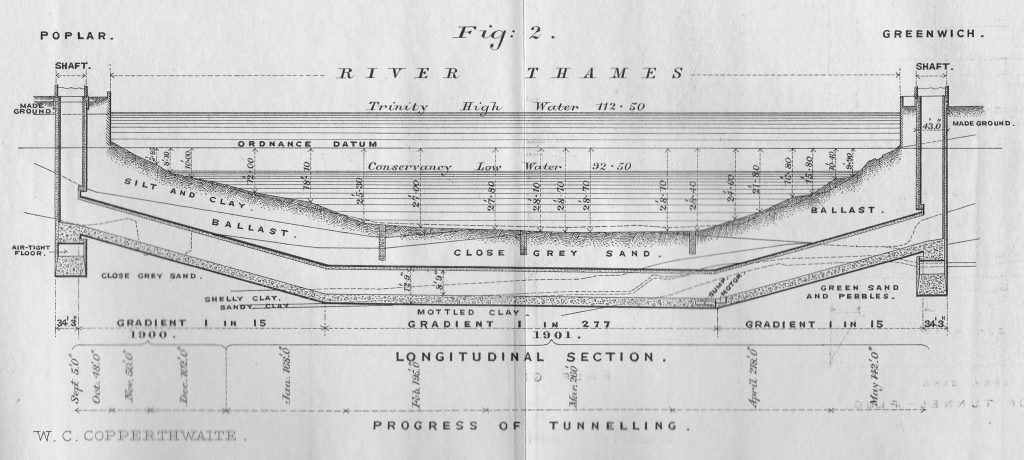
The diagram also shows the type of material that was being excavated through, and was a key consideration in the tunneling method used.
The drawing is a text book example of how to present lots of information in a single drawing. As well as the key lengths, gradients of the tunnel, high and low water level of the Thames, depth of water, dimensions of the shafts etc. the Progress of Tunneling at the bottom of the drawing shows how the tunnel was making its way under the river through 1900 and 1901 as it started from the Poplar shaft and headed to the Greenwich shaft.
Newspapers reported on reaching the half-way point:
“IT IS NOW HALF-WAY TOWARDS COMPLETION – A new tunnel between Poplar and Greenwich is another step in the piercings of the river bed which the London County Council splendidly inaugurated with the making of the Blackwall Tunnel.
The new tunnel will be opened to the public in about a year’s time, and, inasmuch as it is being made wholly in the interests of working men, it might be called the ‘Working Men’s Tunnel’. From shaft to shaft it will measure 1217 feet in length, and will cost about £109,500. The depth of the tunnel at the centre of the river is about 72 feet below the ground line, while the shafts have been sunk to an average depth of 63 feet.
At no part will the top of the tunnel be less than 13 feet below the river bed. No fewer than 1600 tons of cast iron tubing will be used in building the tunnel which will be lighted by electricity. You will approach the tunnel from the Greenwich side from the north end of Church Street, in the rear of the famous Ship Tavern; and on the Millwall side at the Western end of Island Gardens. Some such easy means of communication between one shore and another has long been needed, and many thousands of people will daily find it very handy once it is opened to the public.”
The lining of the tunnel was made up of cast-iron segments, of which eight segments and one key piece formed a complete ring around the tunnel. The lining was 12 feet, 9 inches in outer diameter and 11 feet 9 inches internal diameter.
The following drawing shows a cross section of the tunnel, including the lining, and ducts for services such as electrical wiring, ventilation pipes and cable conduits.

The interior of the tunnel was lined with white glazed tiling, which is still in place today.
The booklet includes some wonderful detail of sections of the tunnel lining:

The washers where the bolts secured the sections together were made using a short section of lead pipe. When the bolt was tightened, the lead would compress forming a water tight seal around the bolt.
Lead wire and iron filings were used to fill any spaces between sections, and the method of construction was so successful, that when air pressure was removed at the end of construction, only a dozen places had a small problem with water ingress and needed repair.
The tunnel was constructed using a shield of the type known as a trap or box shield, which the booklet describes as follows:
“The trap consisting of two diaphragms, the front one filling the upper half and the back one the lower half, of the circle enclosed by the cylindrical skin of the shield.
The bottom of the front diaphragm is a few inches lower than the top of the back one. In the event of an inrush of water from a ‘blow’ occurring at the face, the water must flow over the top diaphragm to get into the tunnel, and before it rises high enough to do this, the bottom of the top diaphragm is under water, and all escape of air through the shield is stopped. the water in fact becomes a seal to hold the air.”
The above description simplifies the design, construction and use of the shield, and cross sections through the shield as used at Greenwich are shown in the following drawings.
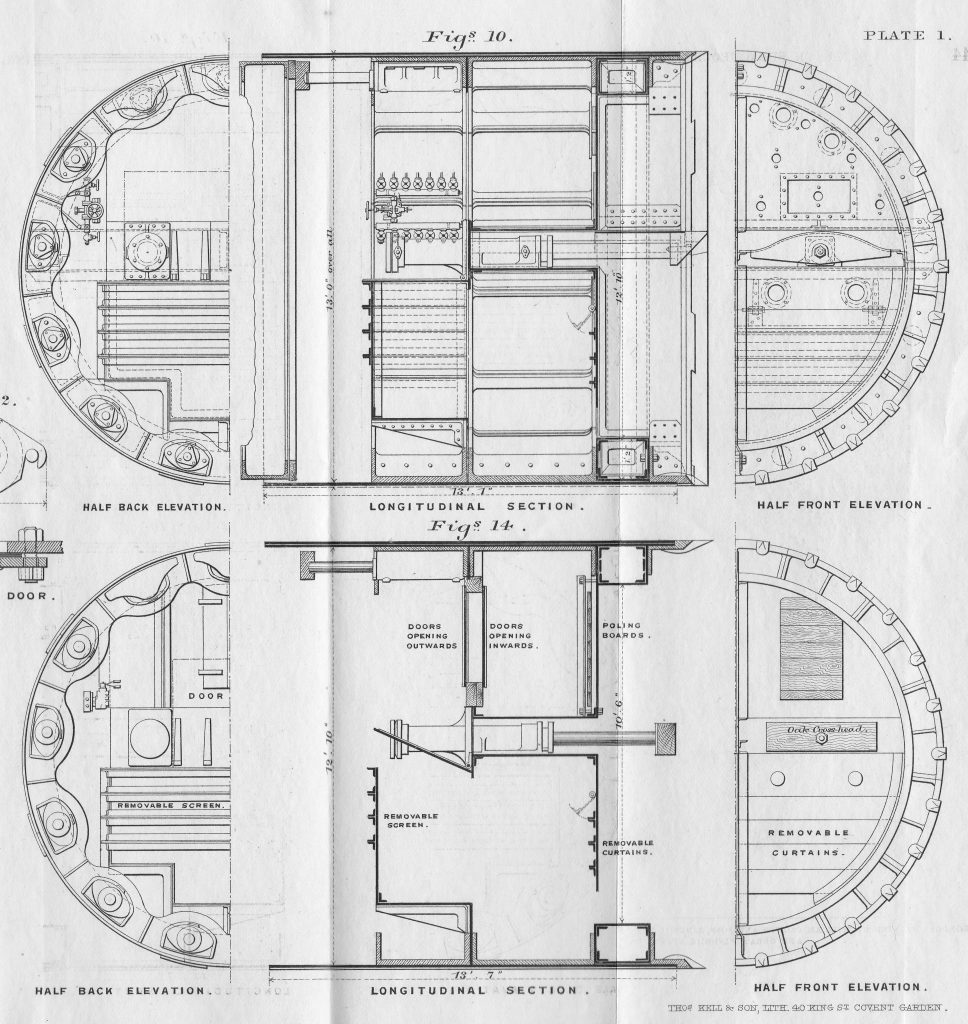
The central box formed a water tight chamber, and the shield consisted of thirteen rams for pushing the shield forward, and together exert a pressure of 1.5 tons per square inch, and a total thrust to push the shield forward of 750 tons.
The design of the shield was changed as it progressed on its route under the Thames, as improvements were identified and as different types of strata were encountered.
This included putting doors in the upper part of the shield, as well as the lower, giving workers an additional method of exit if there were problems at the face of the tunnel. It was noticed that after these additional doors were added, workers were more inclined to stay at the face of the shield after there had been a fall of material, as they had a higher route of exit than before.
As well as the safety of workers at the shield face, another consideration was the conditions of working in an environment where compressed air was used. As well as care of their workers, there was also probably a financial motivation as the Act of Parliament authorising the tunnel included compensation to those whose health had been damaged by working in compressed air. Compensation seemed rather limited though as a total of £20 had been awarded to three workers.
Two medical officers were appointed to oversee the construction of the tunnel. Those working in the tunnel were examined at least once a week and before anyone could commence work, they had to have a certificate of health from the medical officers.
Of those who applied to work on the tunnel, 13.9% were found to be unfit to work on initial examination, and of those who passed the medical, a further 5.7% were found to be affected by the increased air pressure, and forbidden to continue work in the tunnel.
Men worked an 8 hour shift with a rest period of 45 minutes, during which time they had to exit the tunnel.
Rooms were available with washing facilities at the construction site for the workers, and hot coffee was served as they left the tunnel.
A “medical lock” was available for treating those with “caisson-sickness”, probably similar to today where a diver has to decompress in a chamber. Only three workers needed to make use of this facility during the construction of the tunnel.
A concern with tunnel construction was the potential build up of carbon dioxide, and as the construction of the tunnel progressed, an experiment was approved whereby an apparatus was made and installed to removed carbon dioxide. This consisted of a series of wooden boxes bolted together. In each wooden box there was an amount of crushed pumice stone. Air was passed through the boxes, and it was found that deposits of carbonate of soda were found on the pumice stone, and that the experiment did result in the removal of some of the carbon dioxide in the air within the tunnel.
Construction of the tunnel was relatively straight forward given the technologies of the time, and construction methods were able to adapt to the changing sand, clay and ballast through which the tunnel was being bored. For a period between the 22nd February and the 1st May 1901, an impressive 10 feet per day was being achieved in driving the tunnel forward.
The tunnel met the Greenwich shaft without any problems, and minor precautions were made to stop any fall of sand or ballast from the area around the shaft as the tunnel was completed.
The Isle of Dogs and Greenwich were finally connected by a walking route.
In the following photo, the incline up to the Greenwich shaft from the centre of the tunnel can be seen:
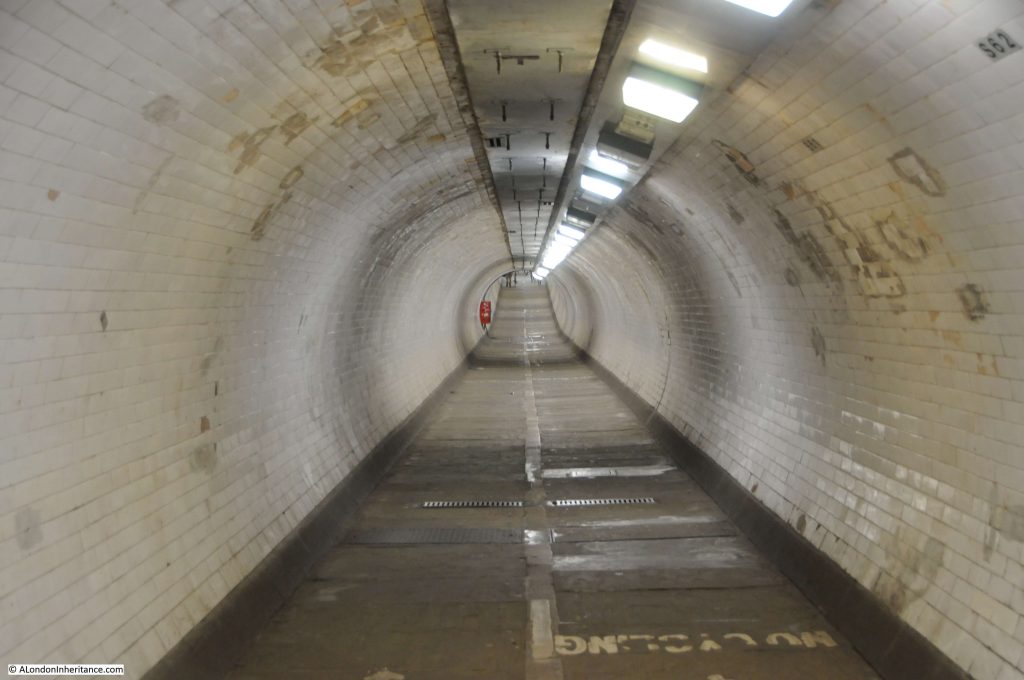
I am not sure whether it was my imagination, however standing in the centre of the tunnel, it seemed possible to hear the sound of the occasional passing boat on the river above.
At the start of the incline where the tunnel rises by 1 foot in every 15 feet, up to Greenwich:

Almost at the Greenwich end of the tunnel looking down the incline:
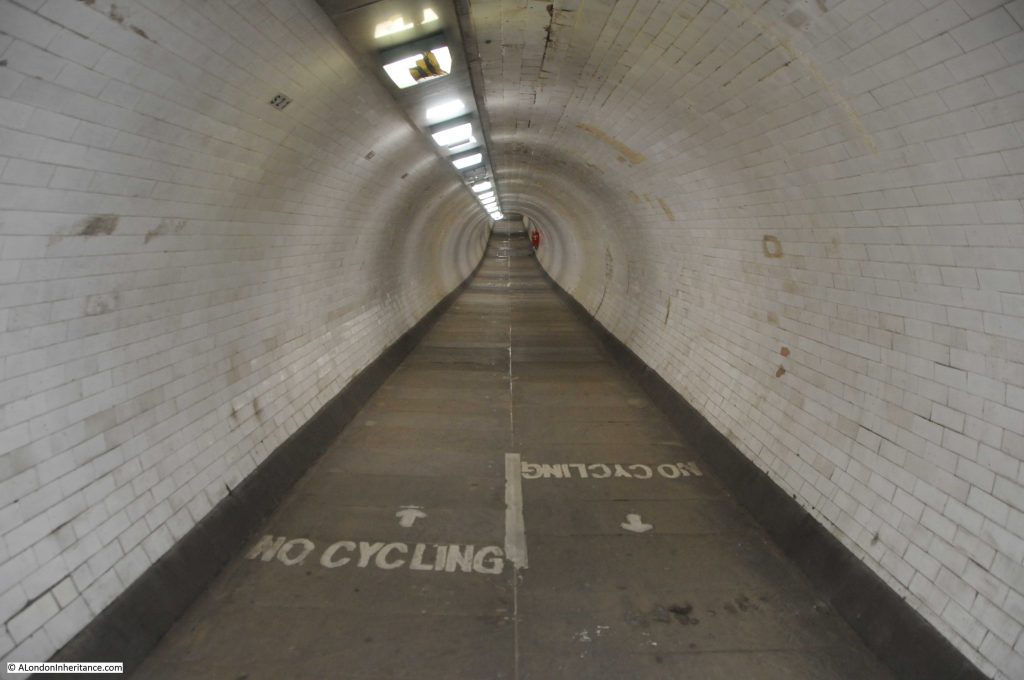
Approaching the Greenwich end of the tunnel, and it looks as if we are approaching an entrance to some secret infrastructure below London – unfortunately it is only the closed entrance to the lift which should be operating.
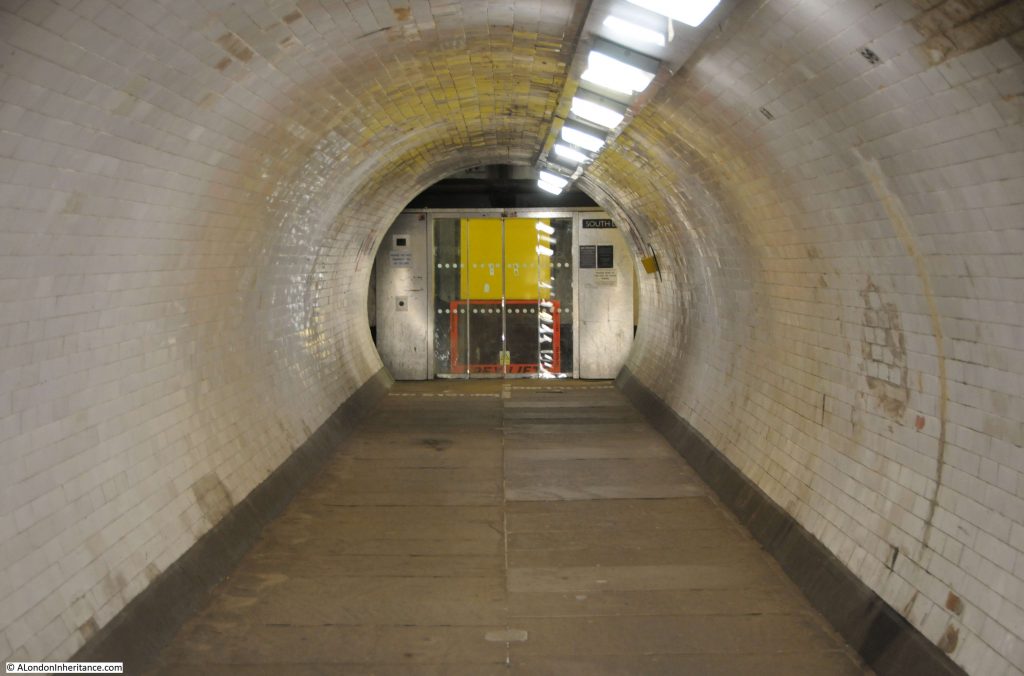
The tunnel today is brightly lit and there is a frequent flow of walkers through the tunnel. It has not always been this way, and as the docks and industries closed on either side of the river the numbers walking through declined and there were times during the 1980s when you needed to be cautious when using the tunnel.
A final look down the Greenwich foot tunnel:
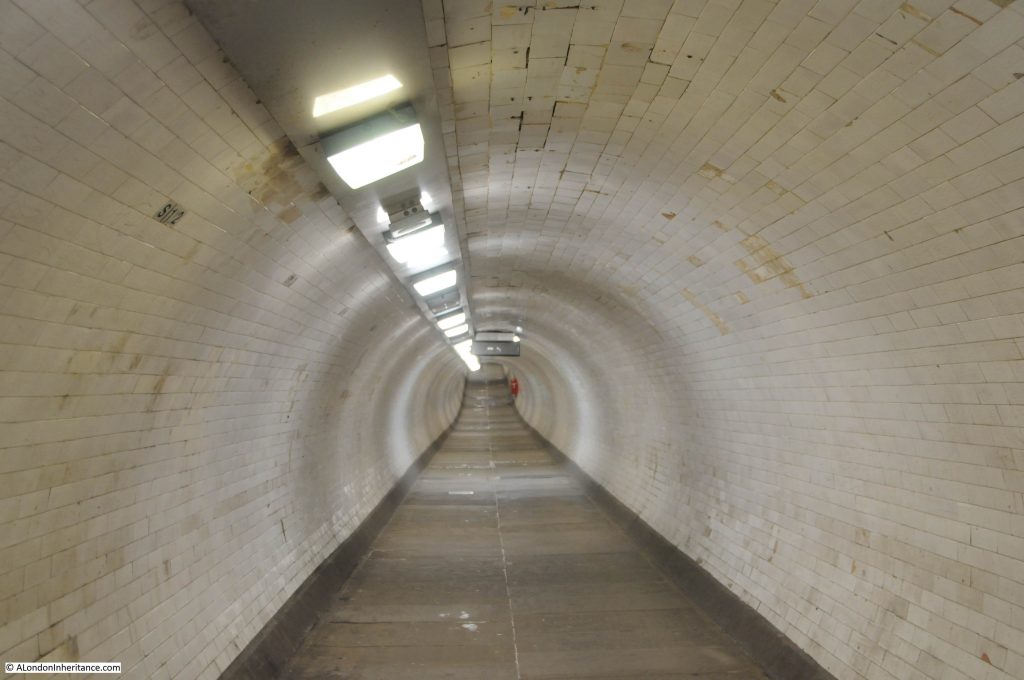
The Greenwich shaft is slightly deeper than the Island Gardens shaft. I counted 87 steps down from Island Gardens, and was rather surprised to count a round number of exactly 100 steps up the Greenwich shaft:

Whilst walking up the shaft, a look up shows the cantilevered steps of the spiral above:
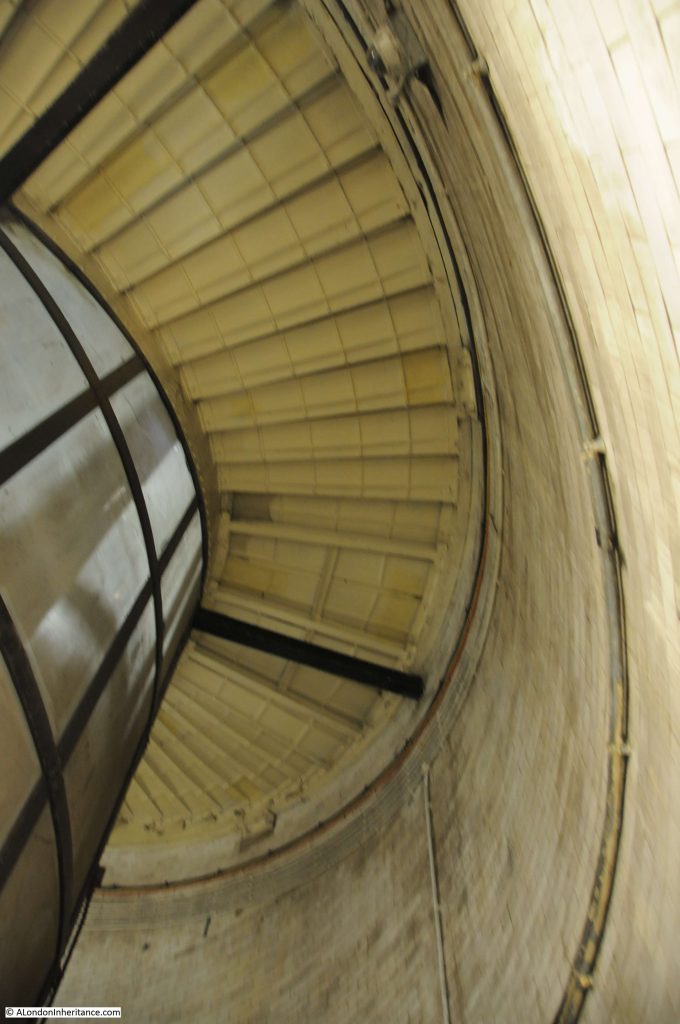
At the top of the steps, one of the current landmarks of Greenwich confirms that you have arrived on the south bank of the River Thames:

But before leaving, another look up shows the wonderful construction of the glass dome that covers the entrance to each shaft:
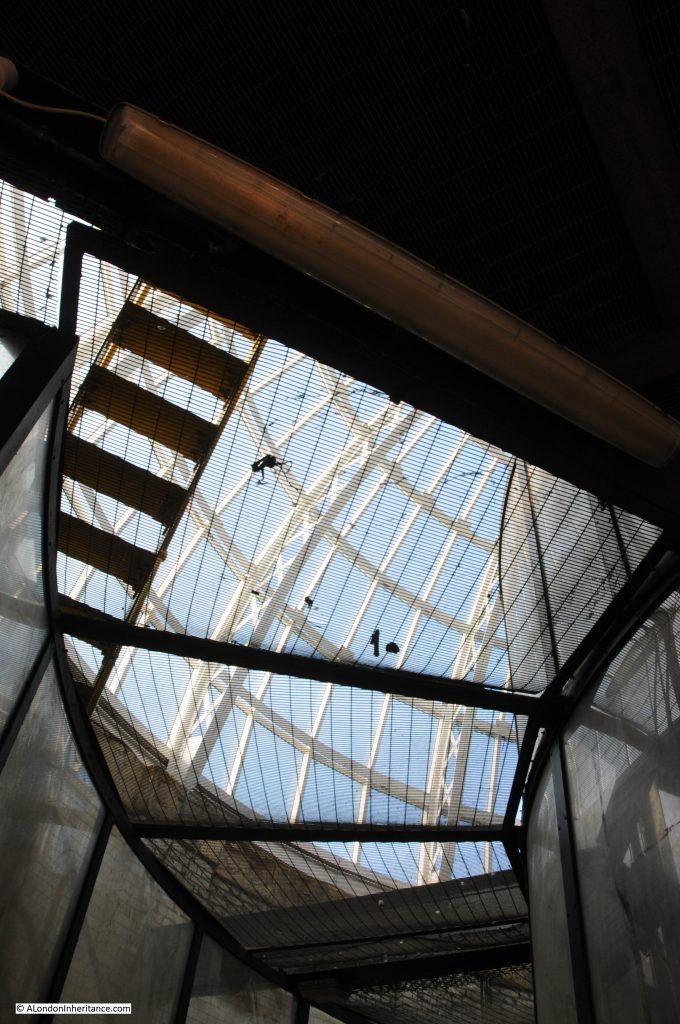
As well as the bomb damage to the tunnel, the entrance buildings and shafts were also damaged by bombing, with an oil filled incendiary hitting the Island Gardens shaft, causing considerable damage to the lift control equipment. The Greenwich entrance was also hit by an incendiary bomb, but did not suffer as much damage as at the northern shaft.

Plaques above both entrances to the tunnel record the opening in August 1902, along with key figures in the London County Council responsible for the tunnel:
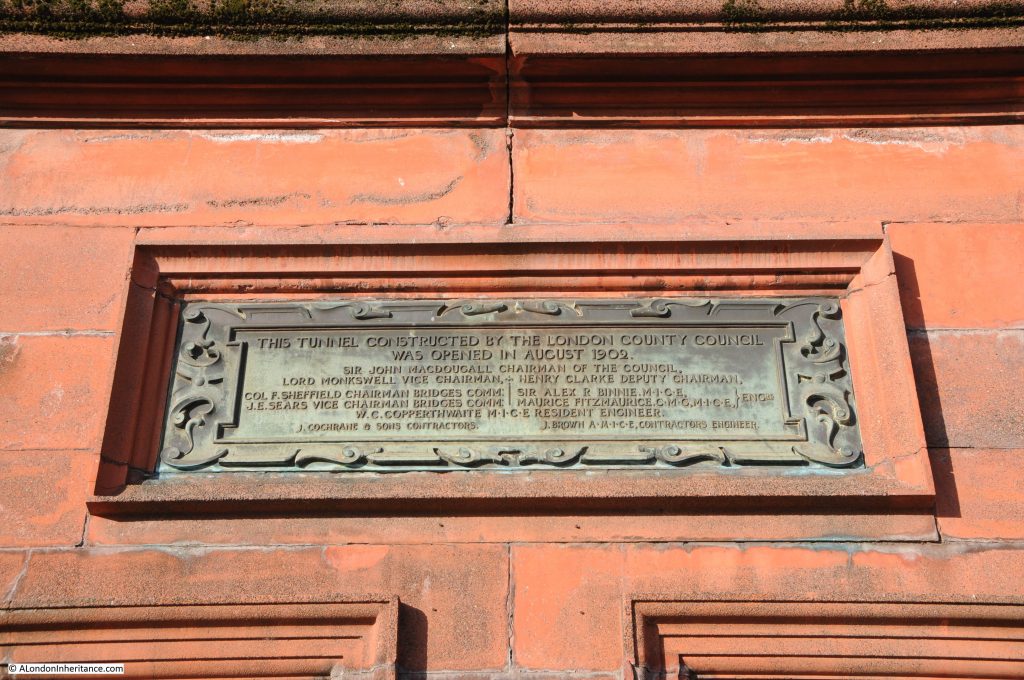
A view of the Greenwich entrance to the tunnel, with the Island Gardens entrance across the river, just to the right:

The original lifts were added in 1904, two years after the tunnel opened, these were attendant operated until the early 21st century. New lifts were installed in 2012, however there have been periods when the lifts were not that reliable, with significant problems with the glass doors closing reliably, and they are currently closed.
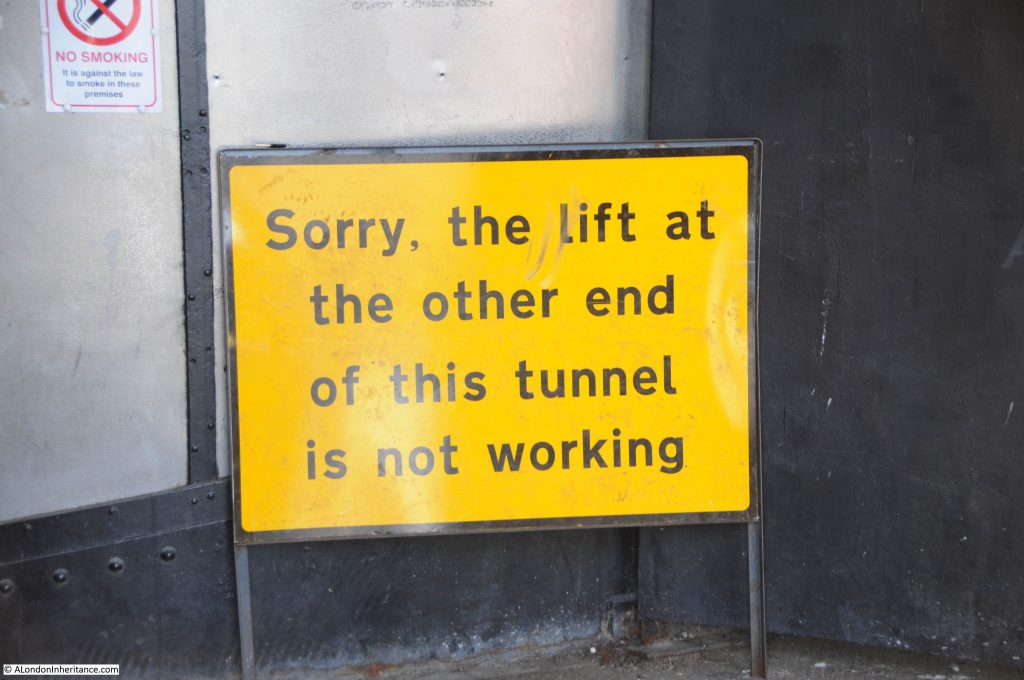
A major problem with the lifts is that they are almost a custom design, having to fit inside the original lift space in the centre of the shaft, and also within such a historic structure.
Special parts for the lifts are sourced from Germany, and it is still expected that the lifts will be closed for some months.
Outside the tunnel entrance is an excellent view of the Cutty Sark:
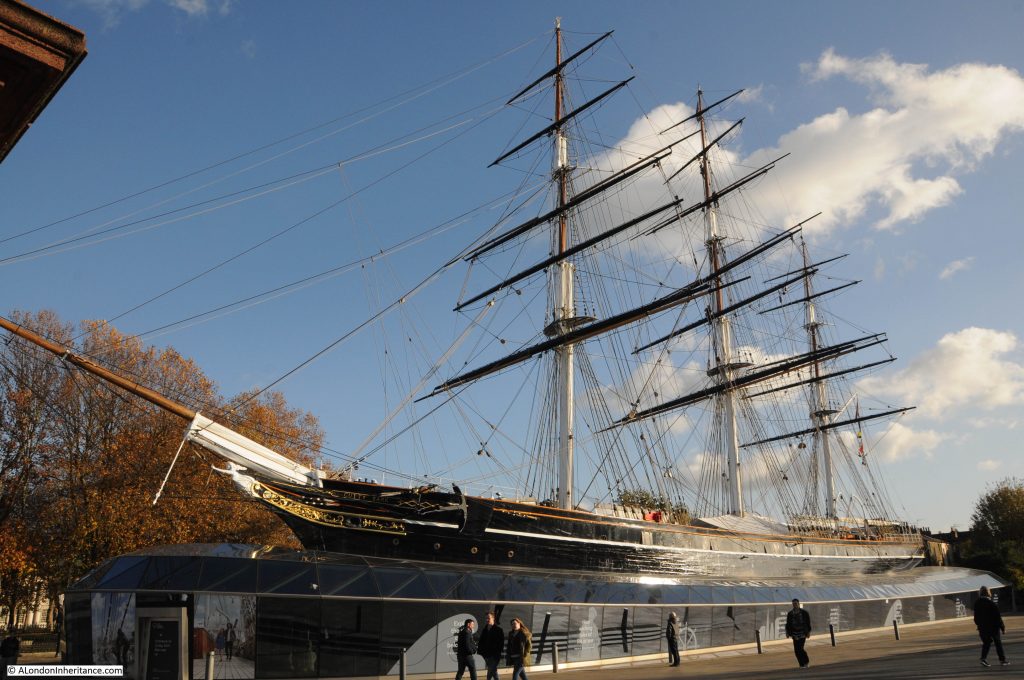
And looking across the river is the ever expanding collection of towers that are growing across the Isle of Dogs:
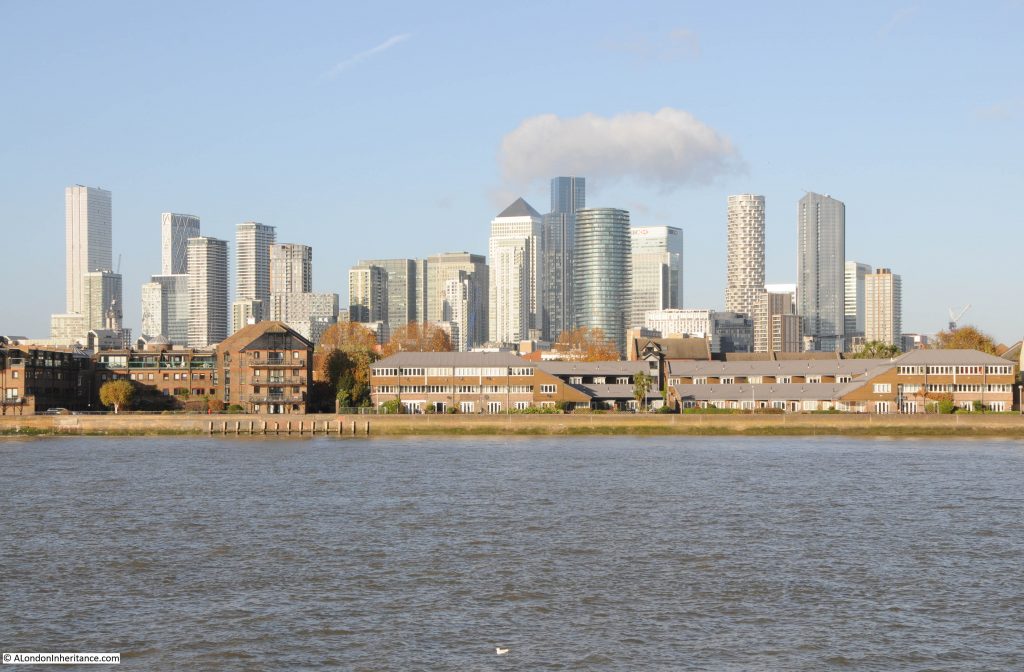
View to the west, towards the City of London from close to the Greenwich entrance to the tunnel:
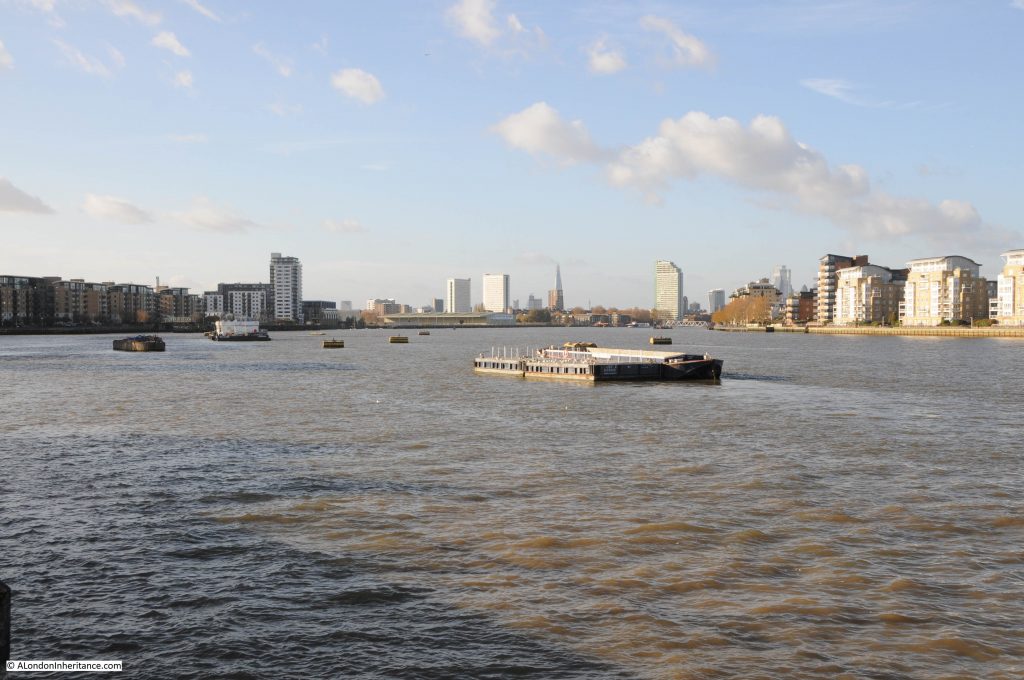
Looking east from the entrance to the Greenwich foot tunnel:
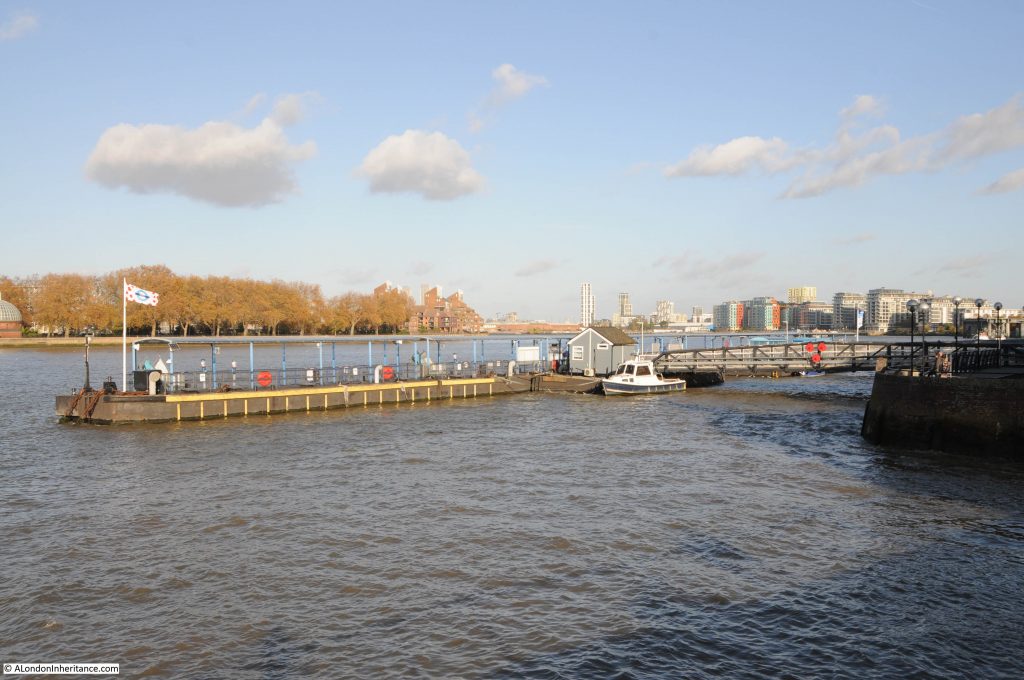
The Greenwich foot tunnel was certainly a success, and a major improvement on the ferry which the tunnel replaced.
A ferry had been operating between the Isle of Dogs and Greenwich for hundreds of years, and such was the level of traffic, that from 1883 the Thames Steamboat Company operated a steamboat ferry, which did have problems operating in a very crowded section of the river (hard to believe when looking at the view today just how busy the river has been).
Despite this, the steam ferry was carrying around 1,300,000 passengers a year, which seems remarkably close to the 1.2 million a year that the Royal Borough of Greenwich state on their website as using the tunnel today.
The booklet states that the foot passenger ferry rights continued to exist after the opening of the tunnel and were owned by the Great Eastern Railway Company.
It would be interesting to know if these rights still exist and whether Network Rail could today run a passenger ferry across the Thames at Greenwich.

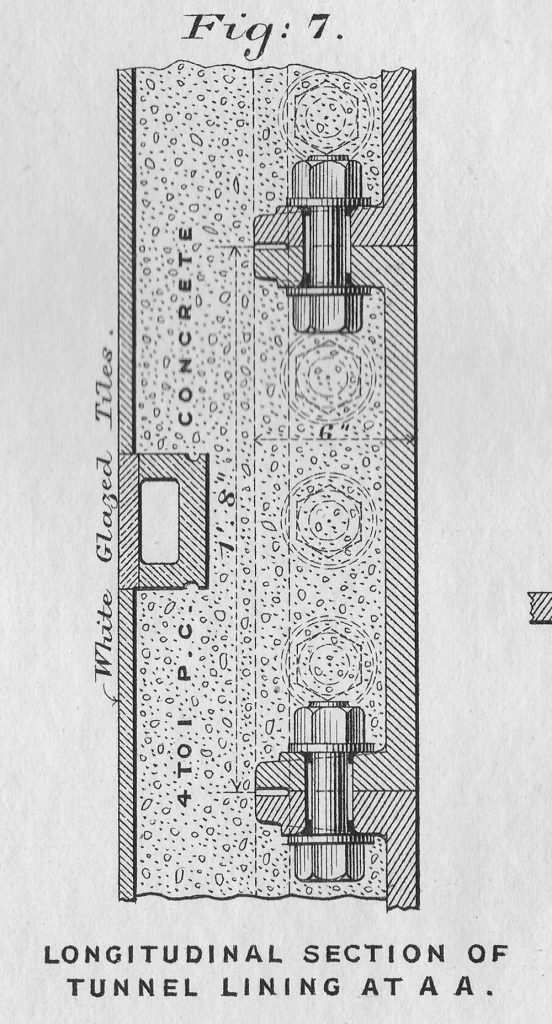
My preferred way of visiting Greenwich was DLR to Island Gardens, foot tunnel to Greenwich and start the return journey from Greenwich station. I used the foot tunnel many a time over the years and look forward to doing so again at some stage.
Thank you so much for this splendidly comprehensive and wonderfully photographed article. Most engagingly informative.
I remember walking through it when I was in my late teens in the 1960s. Loved it.
Excellent and entertaining article. I live in Charlton and often use the tunnel to get across (or rather, under) the river, in order to explore the Isle of Dogs
Very interesting!
Thank you!
Thanks . The blog has been received fine ! It takes me back to using it in the late 70s as part of one route to a placement in Deptford when I lived in Bow ! It’s a fantastic piece of engineering and well worth traversing both ways . Thank you….as ever !
From approximately the age of 7 in 1964 every Sunday my father and I would spend the afternoon on our cycles,leaving from our flat in Bermondsey. One of our usual trips was to The Surrey Docks, following the river up to Greenwich. We would continue following as close to the Thames as we could and eventually reaching Blackwall Point. We then cycled through the Blackwall Tunnel, following the river and then cycled back through the Greenwich Foot Tunnel and home to Bermondsey. Traffic was very light on a Sunday in those days!
During the 90s when British Rail were constantly having strikes, my mate used the tunnel on his journey from Welling to work in the City. He said it was a well used route on those days.
For three or four years around 2002 I used the tunnel every day as part of my route to work on the Isle of Dogs. The lifts each had an operator, so I had to use the stairs early or late when traveling outside the operator’s work day. The Island Gardens lift operator lived locally in Manchester Grove and was a thoroughly nice chap! During his break he’d have a coffee at the little cafe alongside the tunnel entrance, and I’d stop for a chat. Cycling through the tunnel was always prohibited, and an old black and white CCTV system would capture anyone trying it. When the errant cyclist arrived at the lift they’d be told in no uncertain terms that because of their behaviour, the lift was not for them. They’d have to carry their bicycle up the 87 or 100 steps. I too had to carry my bicycle up and down those steps for very many months; not as punishment for cycling through the tunnel, but because the lifts were ALWAYS breaking down! The story was usually, “waiting for specialist parts” – at that time from Poland, not Germany, or so we were told. Another reason given for lift failures in summer, was that sun caused a very high temperature under those glass domes and affected the control circuitry at the top of the lift shaft.
The London Underground Map for 1987 shows the tunnel as a connection from Island Gardens DLR station to Greenwich.
I only just picked this up =woke up late – and someone has already put a link on the Greenwich Industrial History Facebook page.
Until a year or so ago I was chairing the Tunnel Friends group FOGWOFT – I don’t know if you picked up on our abandoned web site and other bits and pieces.
Quite honestly this is the best report I have seen on the tunnel – and I have seen – and written – a lot. Some comments – hope you don’t mind.
The origins of the down river tunnels goes back to the 1870s and calls for parity of free crossings downriver after tolls on upriver bridges were abolished. To a certain extent the LCC were implementing policy already in place
I didn’t know the Copperthwaite stuff had been published as a booklet beyond the academic-professional press He is easily the most important source on the history of the tunnel. He was complemented by a speaker we had in the 2010s on how analyses of the river bed are done today.
Your report on the bombing is beyond excellent.
There are a two professional reports into the recent refurbishment of the tunnels
The new lifts have been far more trouble than you indicate – there was a problem with overheating and much more. The firm who made them have moved to Germany which appears to be Brexit related.
There is an ongoing problem with cyclists – and considerable hostility to them was reported in the East London Press. Various experimental ways of dealing with these problems had to be put on hold.
There is an issue over trying to get the tunnel bylaws changed -which FOGWOFT worked hard to achieve.
Could go on for hours about all this.
Ought to shut up – my next weeks piece in Greewich Weekender is quoting you on the Lewisham Anchor Brewery.
As a school-kid in the 1960s, in the school holidays I often accompanied my greengrocer stepfather on one of his regular early-morning trips to Greenwich fruit and veg market. This usually gave me an hour or so free to wander off and “explore”. The Tunnel was just a couple of minutes walk away and I visited it regularly. I seldom had time to walk all the way through, though. Getting my first wristwatch for my tenth birthday made a lot of difference!
I recall (in about 1967/8?) when Sir Francis Chichester’s Gipsy Moth IV was put on “permanent” display near the Cutty Sark, and very near the Greenwich entrance to the Tunnel. It stayed there until around 2004, I think, although I’d long since stopped being a regular visitor by then.
Thanks for the fascinating detail about the Tunnel’s construction. It seems to have been pretty sophisticated for the time.
Keep up the good work!
Tom
couple more quick comments
you don’t mention Alexander Binnie who as LCC engineer was responsible for the tunnel. FOGWOFT & GIHS have had talks from his great-grandson, Chris Binnie, who has worked on the Tideway Tunnel himself
The geologist who works today on riverbeds for tunnelers is Dr.Jackie Skipper – fascinating!!
couple more quick comments
you don’t mention Alexander Binnie who as LCC Engineer was responsible for the tunnel. FOGWOFT & GIHS have had talks from his great-grandson, Chris Binnie, who has worked on the Tideway Tunnel himself
The geologist who works today on riverbeds for tunnellers is Dr.Jackie Skipper – fascinating!!
Great research – didn’t know it was bombed. I used to trek through the tunnel in mid 1980s to Greenwich Market from Mile End via a bus to Island Gardens every Sunday morning. I had a stall trying to sell my photographs of London. The DLR makes it a lot easier to get to Greenwich these days. When I visit London I always head to Greenwich. Fascinating place and lots of happy memories going there with my Dad in the 1970s too.
This comment doesn’t add greatly to another wonderful post but the 1887 Jubilee 1d. Large Pocket Map of London has this delightful take on the area – ISLE of DOGS – A dismal, swampy sort of place on the river, between Limehouse and Blackwall. Nearest Steamboat Pier, Milwall.
Without the Greenwich Foot Tunnel, my parents would never have met.
My mother lived on the Isle of Dogs, and because there wasn’t a cinema or dance hall on the island, she and most of the other young people had to come over to Greenwich for their entertainment.
My father lived in Old Woolwich Road, Greenwich. They both loved dancing which brought them together.
I can remember walking through the tunnel with my mother, to see my grandmother and aunty. They lived in a terrace house in Douglas Place, which was a short street leading into Millwall Park, before the DLR Island Gardens station was built on the site.
I enjoyed going down in the lift, which at that time, had dark wooden seats round the back edge, and had the same wooden slats on the floor.
Children always enjoyed shouting and singing, to hear the echo through the tunnel, we were encouraged to walk on the right side, and not ride our bikes.
Great memories, thanks
Do you know a piece by Stella Duffy called ‘From the River’s Mouth’? It has a very original take on the Greenwich foot tunnel. It’s too long to send as a comment but I couldn’t see an email address on the site that I could send it to.
The hyperlink at the top of this page entitled “A LONDON INHERITANCE GUIDED WALKS” mentions :-
admin@alondoninheritance.com
Thank you, didn’t even know the tunnel existed. Remember a school trip to Grenwich in 60’s but we went from the Tower on a boat, singing pop songs all the way. Very happy memory.
You make Sunday morning something special to look forward to in Ontario, Canada,
Made many trips through the Foot Tunnel from home on the Shadwell/Wapping border to my PGCE course at the University of Greenwich in Avery Hill. Lifts weren’t running early morning and only occasionally upon my return at the end of the day. Between that and the Shadwell or Wapping Underground stations, seemed to spend quite a lot of time under the Thames. Miss it all sorely!
As a child in the 1950s I and friends used to run through the tunnel shrieking as loudly as possible due to the echo. Happy days
I will add this to the Power Station accumulator for my next London trip. Excellent work as always.
John
Lovely and thorough engineering and social history. Thanks you. I use the tunnel as the crossing of choice to visit the Greenwich market, park and Maritime Museum and love the experience of solo walking across, growling at the cyclists who cannot resist riding through something so wonderful.
Your end thought about a ferry company running a service across the river made me smile as I look at ‘the white elephant line’ at Woolwich. This is surely the worst ferry service in the UK in its’ last dying twitches and will pass into history when/if the Silvertown tunnel is built.
Early Island industry demand has given us a working pier at Mast House Terrace, but this is just too far away from Island Garden for the Uber Riverboat service to act as a ferry. There is also no pier on the north bank at Island Gardens..
Thanks for the history, the inheritance and and for sharing your love of London.
Our author wonders if Network Rail might still possess the rights to operate a ferry here. I don’t know but, I’m intrigued that the 1888 incarnation of the ferry was built as a train-ferry. Perhaps the Great Eastern Railway had intended that its passengers arrived at a railway station in Greenwich? The tracks, to nowhere, on the Essex bank can be seen as a dead-end in Ferry Street on this 1896 map…
https://maps.nls.uk/view/101202486
Despite living in Battersea I and my boyhood chums would sometimes make our way to Greenwich just to visit the tunnel. I seem to remember making a lot of noise and having great fun racing up the stairs. I’m pleased to see from these replies that we weren’t alone!
All the best
Ian Bull
Ian – I know someone who did an enormous amount on this issue some years ago – and came up with nothing much – they looked at Great Eastern Co, records among other things. Although there may be other places to look. The thing is though that there is absolutely no evidence of a rail link on the Greenwich side or anything which might indicate it. As you know there is evidence up at Upper Watergate but not at Wood Wharf. I’ve got various bits and pieces I can look out if you like, but its very inconclusive. I seriously don’t think there is any link with the foot tunnel though.
Very interesting article as always – and it’s great to see how the tunnel has got a new lease of life in recent years again since it’s decline when the docks closed. Whenever I go through it’s always very well used.
Not sure if some one else has pointed out that the reason the Greenwich end has more steps than the Isle of Dogs is because Greenwich is higher – an old old notice at the foot tunnel used to say 6 feet higher.
Yes, the blpg did arrive and thanks for this – evocative and informative and beautiful as ever
A really interesting article, especially the technical information. Me and my mates used to walk through this tunnel from the Greenwich side to the Island Gardens and back – it was a bit of an excursion from where we lived in Wapping. This was in the 60s when we went to Greenwich Park to hunt for conkers.
Well done sir another great history lesson
I lived in Millwall until I was eleven (in 1958), I must have walked through that tunnel in the high hundreds of times, to visit relatives in Lewisham, to go to Greenwich Park, which I adored and on Saturday mornings to watch appalling films at the Greenwich Odeon(?), also loved the Greenwich Market.
Though this is an excellent and very informative article about the tunnel, one thing missing though is photo’s of the lifts, the original ones, cant find any anywhere which is a shame because they were beautiful. If anyone knows of a link…..
Hullo Steve
The two links below should be of interest…
https://islandhistory.wordpress.com/2015/04/01/greenwich-foot-tunnel/
https://islandhistory.wordpress.com/2015/10/25/the-other-end-of-the-tunnel/
Thanks for those.
Ian – Steve – I covered the Ship Hotel etc and the history of the area round it in one of my articles for Greenwich Weekender and repeated them in my more recent book on the Greenwich Riverside. There is also a book by Greenwich Library staff produced in – I think – the early 1990s about that whole area.
Also, as you know, I was one of the people involved in the Friends of the Greenwich and Woolwich Foot Tunnels. There is very much still a role for such an organisation. What needs to change are the bylaws – particularly on fines – but it is my understanding that LBTH has still neither commented on nor agreed changes after some years.
Mary – I was sad to see FOGWOFT disband, thanks largely out of frustration with the authorities lack of effort/progress. Steve might want to see this…
https://fogwoft.wordpress.com/history-2/
I last used the tunnel a couple of weeks ago, all was well except for a speeding cyclist.
It wasn’t about frustration- one committee member died, and another left because of unspecified disagreements. We had a good relationship with Greenwich Council – but the staff member we liaised with left. And for a while it went very well – when Greenwich put their star project worker on it – then he retired too. I think we rather regret winding it up but we needed more support. I am in touch with the two councillors elected for the area its in – actually the new ward boundary almost goes through the middle of it. But the non-progress on the by laws was a sticking point – and also the understandable hostility on the Island to cyclists (from south London) in the tunnel. I have been wondering whether to reawaken it as an arm of GIHS but old age and other interests mean we need someone active involved to do the leg work.
Thanks for clarifying that, Mary. If I didn’t live on the other side of London I’d have been happy to lend a hand!